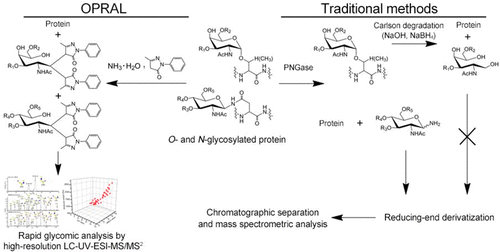当前位置:
X-MOL 学术
›
J. Proteome Res.
›
论文详情
Our official English website, www.x-mol.net, welcomes your
feedback! (Note: you will need to create a separate account there.)
Simultaneous Release and Labeling of O- and N-Glycans Allowing for Rapid Glycomic Analysis by Online LC-UV-ESI-MS/MS
Journal of Proteome Research ( IF 3.8 ) Pub Date : 2018-05-24 , DOI: 10.1021/acs.jproteome.8b00038 Chengjian Wang 1 , Yu Lu 1 , Jianli Han 1 , Wanjun Jin 1 , Lingmei Li 1 , Ying Zhang 1 , Xuezheng Song 2 , Linjuan Huang 1 , Zhongfu Wang 1
Journal of Proteome Research ( IF 3.8 ) Pub Date : 2018-05-24 , DOI: 10.1021/acs.jproteome.8b00038 Chengjian Wang 1 , Yu Lu 1 , Jianli Han 1 , Wanjun Jin 1 , Lingmei Li 1 , Ying Zhang 1 , Xuezheng Song 2 , Linjuan Huang 1 , Zhongfu Wang 1
Affiliation

|
Most glycoproteins and biological protein samples undergo both O- and N-glycosylation, making characterization of their structures very complicated and time-consuming. Nevertheless, to fully understand the biological functions of glycosylation, both the glycosylation forms need to be analyzed. Herein we report a versatile, convenient one-pot method in which O- and N-glycans are simultaneously released from glycoproteins and chromogenically labeled in situ and thus available for further characterization. In this procedure, glycoproteins are incubated with 1-phenyl-3-methyl-5-pyrazolone (PMP) in aqueous ammonium hydroxide, making O-glycans released from protein backbones by β-elimination and N-glycans liberated by alkaline hydrolysis. The released glycans are promptly derivatized with PMP in situ by Knoevenagel condensation and Michael addition, with peeling degradation almost completely prevented. The recovered mixture of O- and N-glycans as bis-PMP derivatives features strong ultraviolet (UV) absorbing ability and hydrophobicity, allowing for high-resolution chromatographic separation and high-sensitivity spectrometric detection. Using this technique, O- and N-glycans were simultaneously prepared from some model glycoproteins and complex biological samples, without significant peeling, desialylation, deacetylation, desulfation or other side-reactions, and then comprehensively analyzed by online HILIC-UV-ESI-MS/MS and RP-HPLC-UV-ESI-MS/MS, with which some novel O- and N-glycan structures were first found. This method provides a simple, versatile strategy for high-throughput glycomics analysis.
中文翻译:

同时释放和标记O-和N-聚糖,可通过在线LC-UV-ESI-MS / MS快速进行糖分析
大多数糖蛋白和生物蛋白样品都经历了O-和N-糖基化,使其结构表征非常复杂且费时。然而,为了充分理解糖基化的生物学功能,两种糖基化形式都需要进行分析。本文中,我们报道了一种通用,方便的一锅法,其中O-和N-聚糖同时从糖蛋白中释放出来,并在原位进行了显色标记,因此可用于进一步表征。在此过程中,将糖蛋白与1-苯基-3-甲基-5-吡唑啉酮(PMP)在氢氧化铵水溶液中温育,使O-聚糖通过β-消除和N从蛋白质主链中释放出来。-通过碱性水解释放的聚糖。通过Knoevenagel缩合反应和Michael加成反应,立即用PMP原位释放释放的聚糖,几乎完全防止了剥离降解。回收的作为双PMP衍生物的O-和N-聚糖混合物具有很强的紫外线(UV)吸收能力和疏水性,可以进行高分辨率的色谱分离和高灵敏度的光谱检测。使用此技术,O-和N同时从一些模型糖蛋白和复杂的生物样品中制备β-聚糖,而没有明显的脱皮,脱唾液酸化,脱乙酰化,脱硫或其他副反应,然后通过在线HILIC-UV-ESI-MS / MS和RP-HPLC-UV进行全面分析-ESI-MS / MS,首先发现了一些新颖的O-和N-聚糖结构。该方法为高通量糖组学分析提供了一种简单,通用的策略。
更新日期:2018-05-25
中文翻译:

同时释放和标记O-和N-聚糖,可通过在线LC-UV-ESI-MS / MS快速进行糖分析
大多数糖蛋白和生物蛋白样品都经历了O-和N-糖基化,使其结构表征非常复杂且费时。然而,为了充分理解糖基化的生物学功能,两种糖基化形式都需要进行分析。本文中,我们报道了一种通用,方便的一锅法,其中O-和N-聚糖同时从糖蛋白中释放出来,并在原位进行了显色标记,因此可用于进一步表征。在此过程中,将糖蛋白与1-苯基-3-甲基-5-吡唑啉酮(PMP)在氢氧化铵水溶液中温育,使O-聚糖通过β-消除和N从蛋白质主链中释放出来。-通过碱性水解释放的聚糖。通过Knoevenagel缩合反应和Michael加成反应,立即用PMP原位释放释放的聚糖,几乎完全防止了剥离降解。回收的作为双PMP衍生物的O-和N-聚糖混合物具有很强的紫外线(UV)吸收能力和疏水性,可以进行高分辨率的色谱分离和高灵敏度的光谱检测。使用此技术,O-和N同时从一些模型糖蛋白和复杂的生物样品中制备β-聚糖,而没有明显的脱皮,脱唾液酸化,脱乙酰化,脱硫或其他副反应,然后通过在线HILIC-UV-ESI-MS / MS和RP-HPLC-UV进行全面分析-ESI-MS / MS,首先发现了一些新颖的O-和N-聚糖结构。该方法为高通量糖组学分析提供了一种简单,通用的策略。











































 京公网安备 11010802027423号
京公网安备 11010802027423号